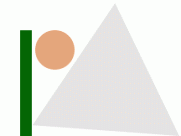
The chip model uses colored beans or chips to represent negative integers and positive integers.
A green bean or shaded circle, , will be used to represent 1.
A red bean or open circle, , will be used to represent –1.
Examples: Here are a few practical examples.
A deposit of $1 may be represented by .
A withdrawl of $1 may be represented by .
Receiving 3 candy bars may be represented as .
Giving away 3 candy bars may be represented as .
Another important concept with the chip model is that there are many different ways to represent an amount of zero.
Examples:
(a) No chips at all would represent an amount of zero.
(b) would represent an amount of zero, e.g., a deposit of $1 and a withdrawal of $1 leaves no change in the balance.
(c) would represent an amount of zero, e.g., receive 3 candy bars and give away 3 candy bars leaves no change in the amount of candy bars.
In other words, two chips of opposite color cancel each other out, so both chips can be removed. This example illustrates the property that 1 + (–1) = –1 + 1 = 0.
Symbolize each problem and illustrate with the chip model.
Sandy has a score of five points in the hole in the card game.
The charge on three protons.
return to top | previous page | next page